THE DARK CRYSTAL: AGE OF RESISTANCE – Season One
A return to the world of Thra, where three Gelfling discover the horrifying secret behind the Skeksis' power, and set out to ignite the fires of rebellion and save their world.
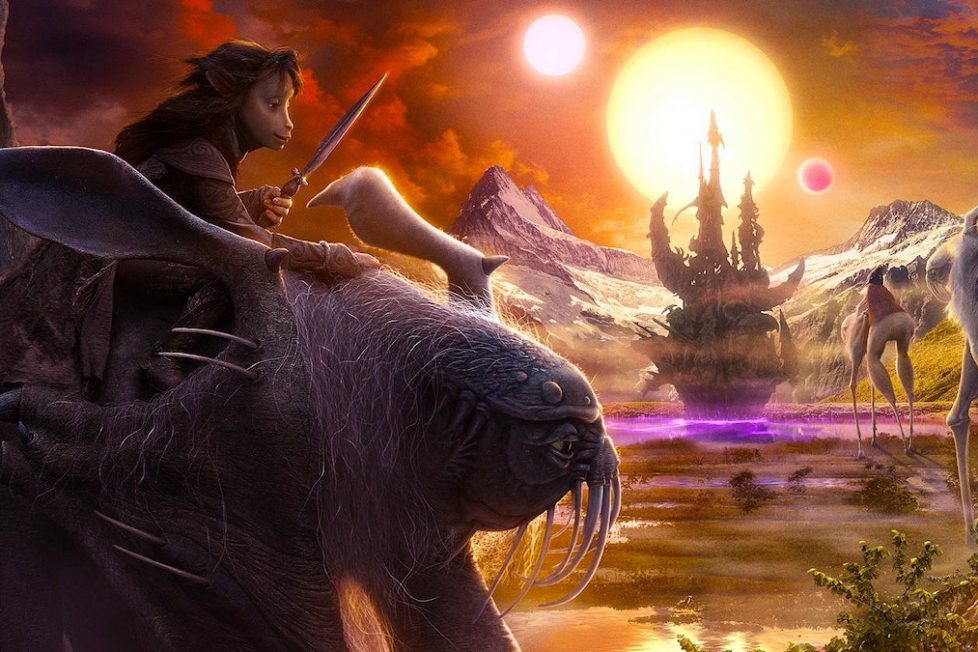
A return to the world of Thra, where three Gelfling discover the horrifying secret behind the Skeksis' power, and set out to ignite the fires of rebellion and save their world.


After the mixed reception for Game of Thrones’ final season, it looks like another high fantasy series will be remembered as the television event of the year. The Dark Crystal: Age of Resistance is an epic tale told against a backdrop of another world that bears a passing resemblance to our own, tackling deep issues concerning political power-play and the human condition. Except this series doesn’t have any human characters at all!
When I heard a return to the world of Thra was in the pipeline, I must confess I was a little worried. Not that I thought it was a bad idea, certainly not, it’s just the original Dark Crystal (1982) was such a huge achievement! It was a high point in the career of the much-missed Muppet maestro, Jim Henson, and over the intervening decades had gathered legions of fans. For those people, it had become part of their childhoods, a touchstone in their personal histories, a rite-of-passage that many have shared with their own children. I count myself among those millions who have a deep affection for the film.
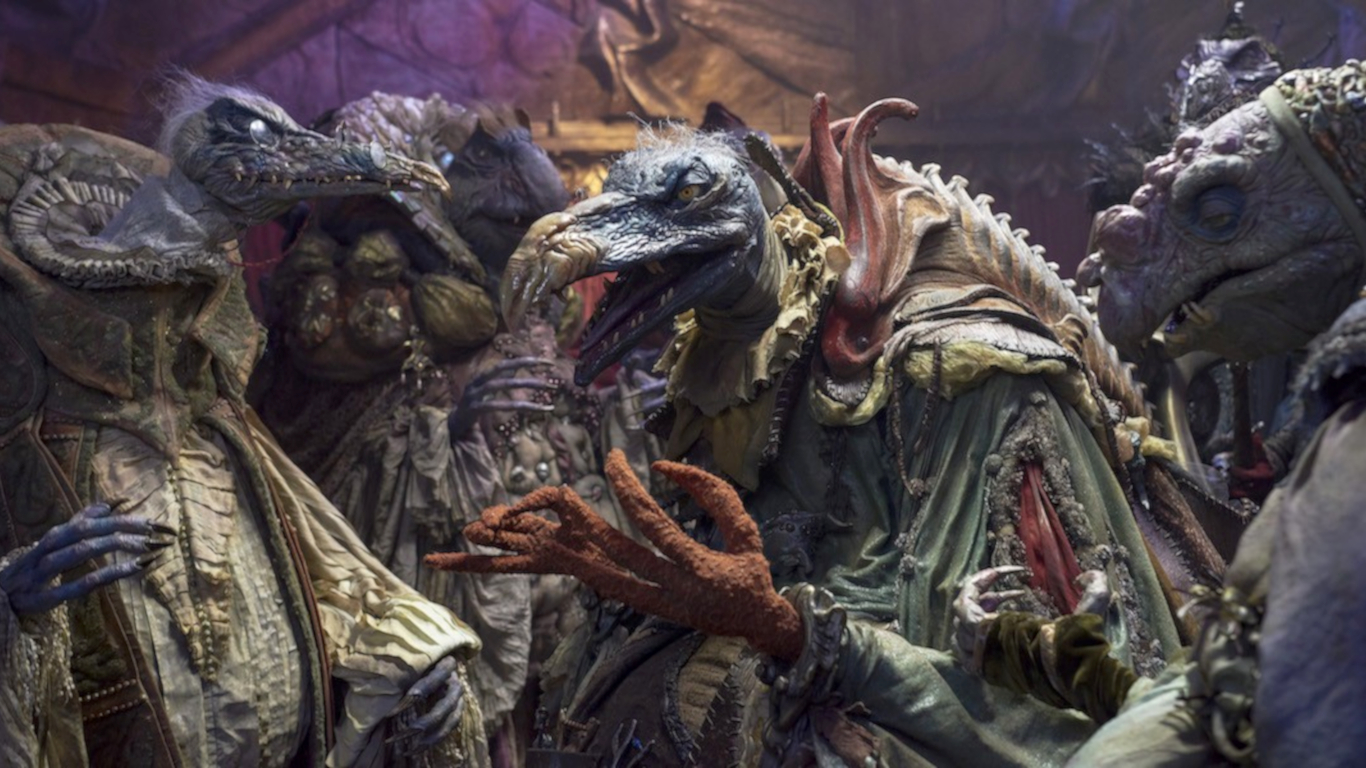
I know adding to that heritage couldn’t besmirch the original because that exists in its own bubble of cinema history, but it would risk treading on all those personal memories and associations. It might make bold steps that dance to the same tune or trample rough-shod in an attempt to reboot and update a classic, which does seem to be the current trend. Then news broke it would combine Henson-style puppetry with “cutting-edge digital effects” and my concerns deepened. How would that mesh and could those rich, beautiful textures in the original film ever be matched by CGI?
So my fan-boy excitement was tinged with trepidation as I sat down with the family to watch the new Netflix series, The Dark Crystal: Age of Resistance. I needn’t have worried. In minutes, we were back in the lands of Thra and immersed in a meticulously realised fantasy world to rival the likes of The Hobbit (2013) and Avatar (2009)! But let’s make one thing clear from the get-go: if you don’t like puppetry or fantasy, this won’t be for you! But if you do, you’re in for a treat.
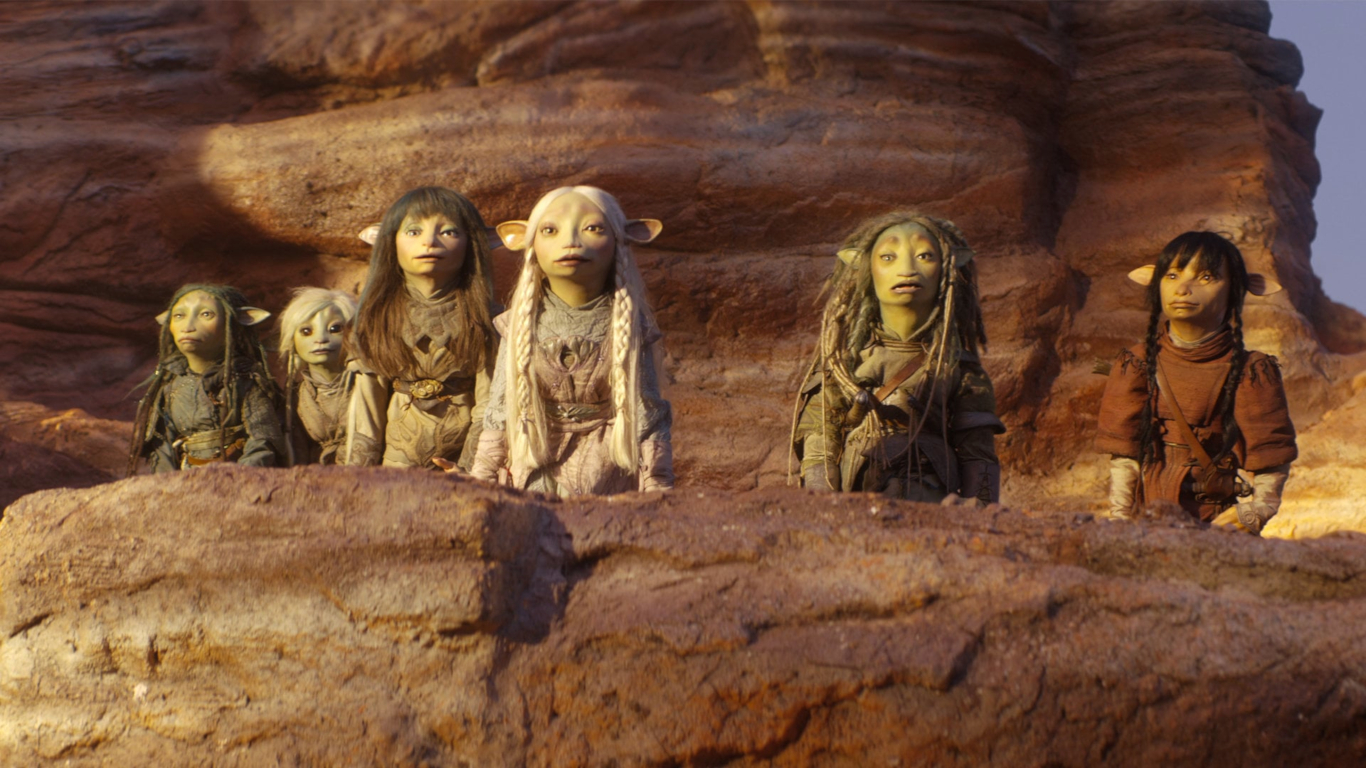
The first hour-long episode, “End. Begin. All the Same”, passed so quickly and kept hitting us in the eye with gorgeous production design: the Sanctuary Tree, the Vapran Citadel and Library, the Castle of the Crystal… This version of Thra is even more richly detailed than the movie and there’s a good reason for this. The original was set at the end of a slow decline into a millennia-long dark age that ravaged and all but destroyed the natural world of Thra. The series is set long before those events, when Thra was thriving and the Darkening had only begun to taint its unifying lifeforce.
It’s this lifeforce that the evil overlords, the Skesis, discover they can drain using the power of the Crystal and, in so doing, prolong their own decadent lifestyles. When these creatures (that resemble dinosaur-vulture hybrids) test their essence-draining apparatus for the first time, we get a surprisingly scary death of one of the main characters. We see the apparatus pierce the flesh of the victim, who’s then totally absorbed instead of being reversibly zombified. Thus, the series proves itself to be as edgy and scary as the film, perhaps more so. And this isn’t the first time a major character will die horribly. And the coup de foudre is that we actually care…
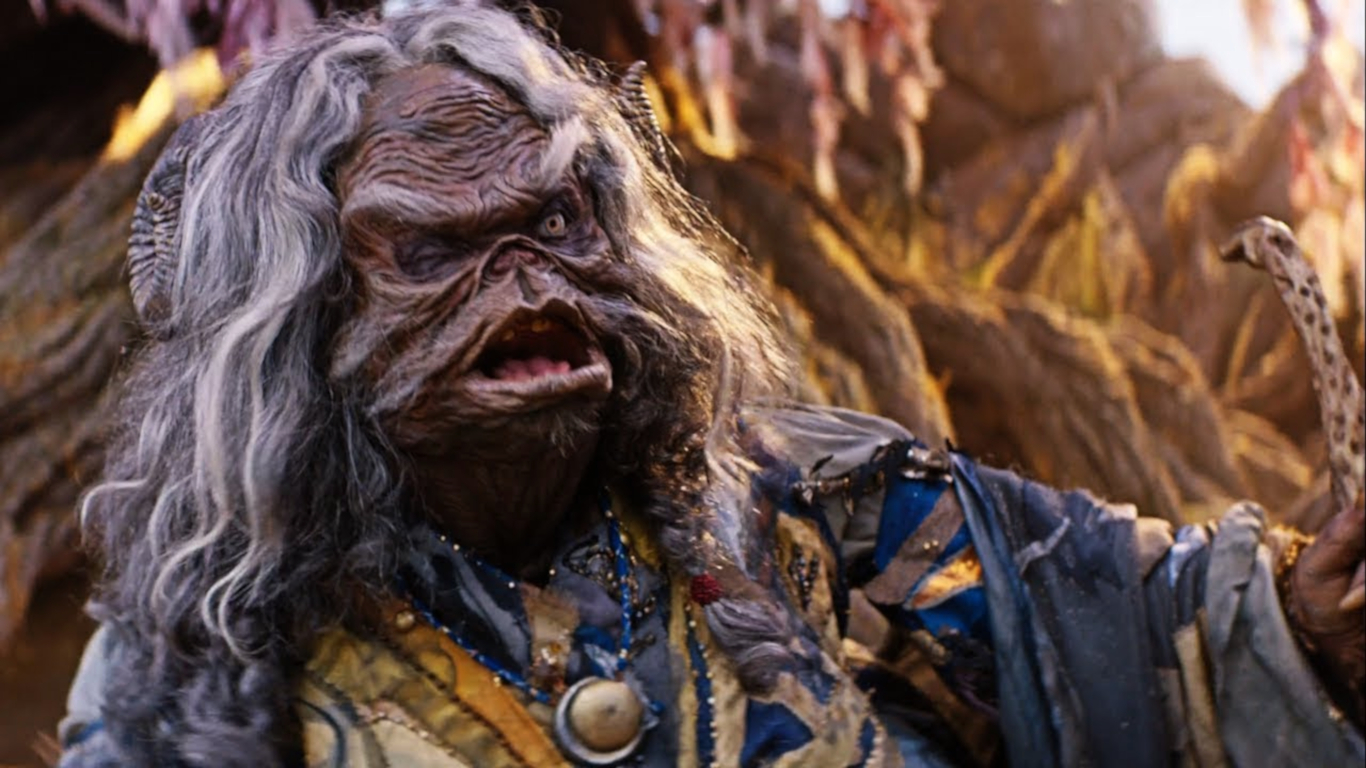
The scare factor is easier for kids to handle because the puppets have already taken one step away from reality. Nasty things happen—we see a Gelfling die on the floor, haemorrhaging quite a respectable pool of blood, while another creature has its eye eaten by a ‘peeper beetle’. None of this would be acceptable in a kid’s show using real actors. There’s nevertheless a strong emotional connect with the characters, so the peril remains stimulating and unnerving. It pushes out of the cosy comfort zone and more into the darker realm of Brothers Grimm fairytales—the versions before Disney sanitised and Americanised them. But a puppet provides a physical buffer zone for emotional impact.
Besides, it’s not really a children’s fantasy, although it does encourage a childlike engagement of the imagination. The story never soft-pedals the content and tackles universal themes as well as some closer to home. Watching in parallel to the parliamentary shenanigans happening around Brexit really made the Skeksis seem like a corrupt political party. They even mirrored what seems to be a trend in our world right now of those in power flouting the law because they feel untouchable, and placing personal gain above their duty as custodians of their people.
The Skeksis are really the stars. We all love a great villain and they’re just so delightfully disgusting and gleefully gluttonous. Of the Skeksis characters, it’s the scheming skekSil the Chamberlain (voiced by Simon Pegg, performed by Warrick Brownlow-Pike) that steals the show, much as he did in the film version. He’s instantly recognisable by his distinctive whimper—which must be one of the greatest ‘catchphrases’ since the heyday of Kenneth Williams and Frankie Howard!
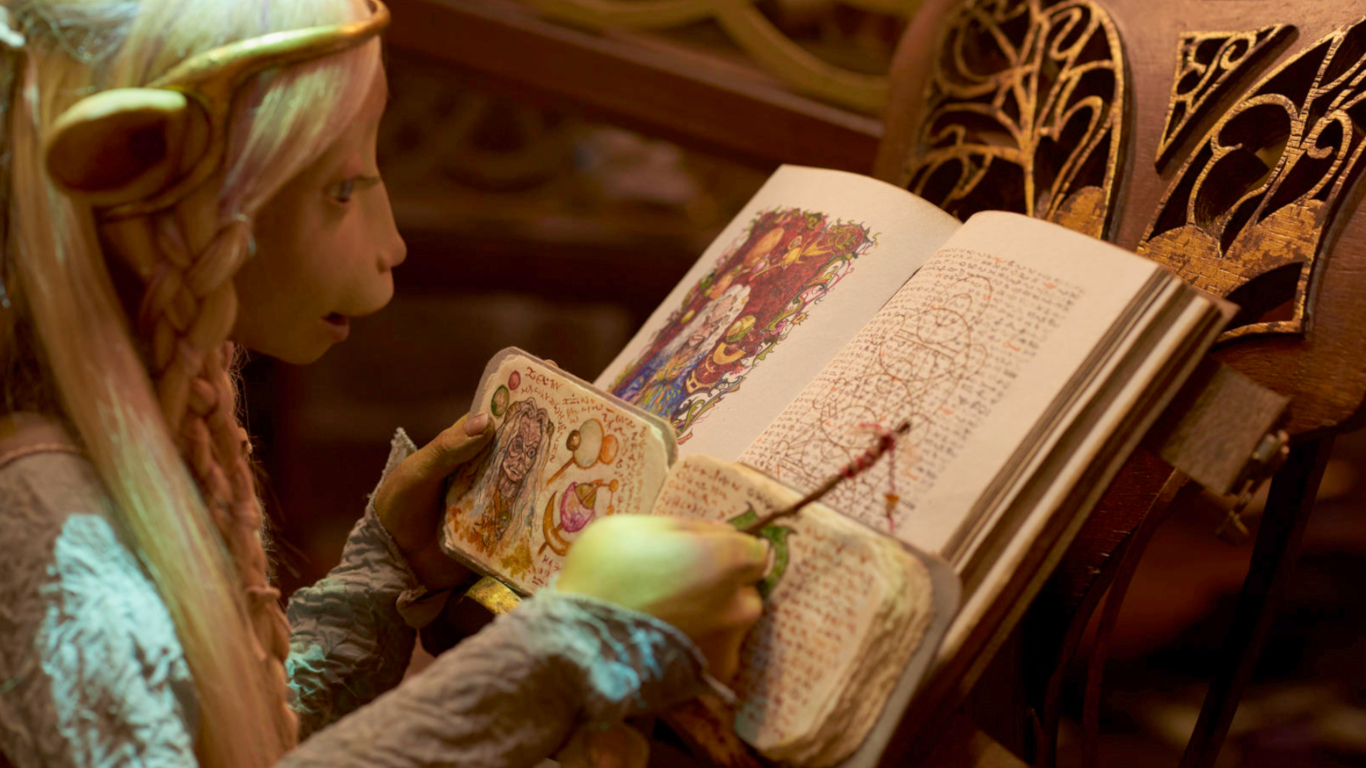
Certainly, minutes into the premiere, I wasn’t seeing puppets anymore. If you allow yourself to get sucked-in by the illusion, the experience is utterly immersive. There are no human actors to jar the senses and break the spell. Everything we see seems to be real and happening in real-time right in front of the camera… but where is that “cutting-edge CGI”?
It seems that after several early tests with puppet Skeskis interacting with CGI Gelflings, the production team had similar apprehensions. It looked too much like video game footage spliced into a different film. So, despite the magnitude of the task, executive producer Lisa Henson and director Louis Leterrier (The Transporter) pushed for an entire 10-part series to be made using the same fully-realised puppetry of Henson’s groundbreaking movie. Netflix agreed to add the necessary time and grant a bigger budget to make it all possible.
Nearly everything does indeed happen right there in front of the camera, with all the actors interacting and Leterrier (usually behind a Steadicam himself) giving directions as things developed. They were able to adapt as any problems arose. Improving as they went so that the already meticulously planned production was allowed room to grow organically, even during the production stage. The modellers, the designers, the costume and set departments, were always on hand and worked like one big team, just like the original production.
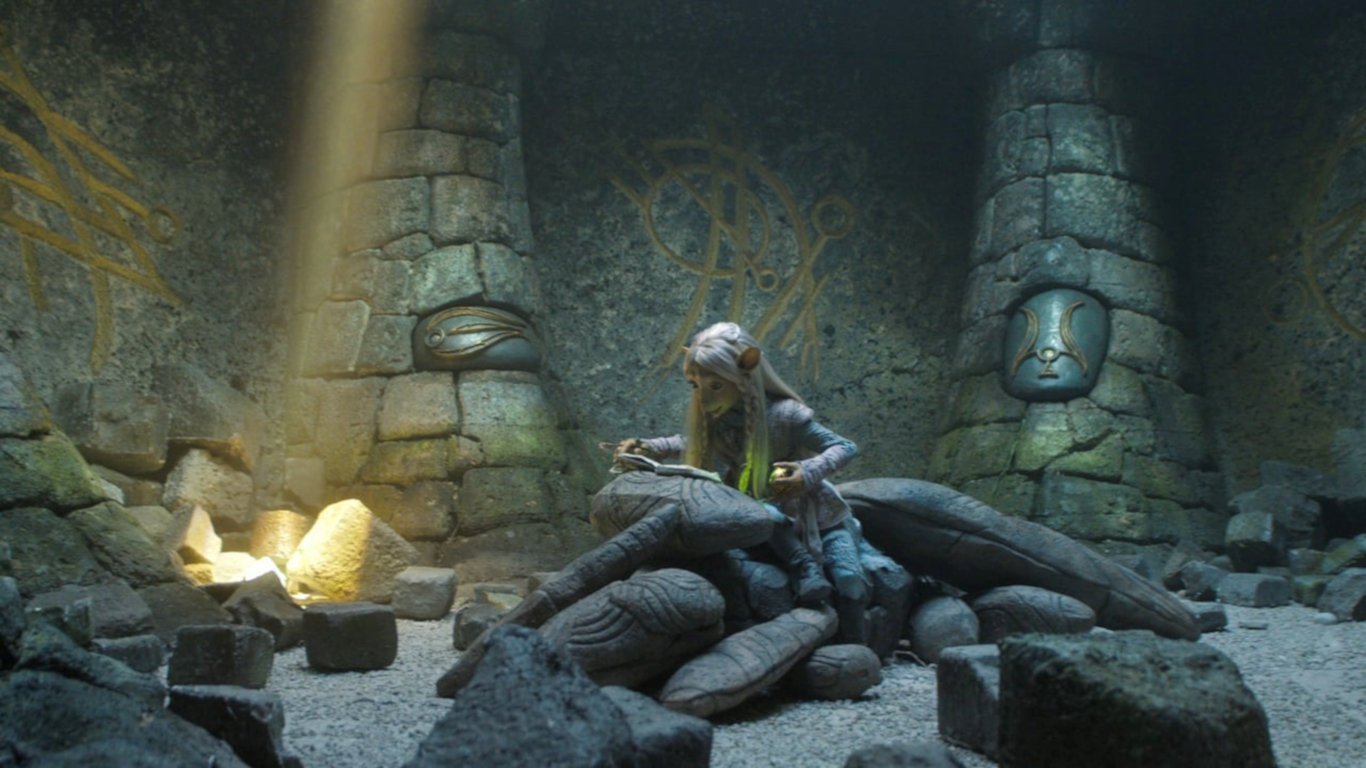
Louis Leterrier’s involvement with the project goes right back to 2012 when he took the helm of a floundering project to develop The Power of the Dark Crystal, a sequel from a script written by Annette Duffy and David Odell. When that fell apart, he remained determined to see a return to Thra and, in discussion with Lisa Henson, decided to look at the rich history already laid out in the notes of Henson, Frank Oz, and Brian Froud, part-summarised in the pivotal ‘Wall of Wonder’ sequence in the film. This gave hints at a rich background story about the origins of the Skeksis and the rise of a Gelfling rebellion. Leterrier thought that this was a great starting point and a prequel began to take form. The Power of the Dark Crystal was eventually realised in the form of some 2017 graphic novels, launched around the same time we started hearing rumours that Netflix and the Jim Henson Company were working on a 3D animated TV series.
Jeffrey Addiss and Will Matthews, both Henson super-fans, were brought in after they had pitched a script for a sequel to Labyrinth (1986) and were hired to co-write and produce a Dark Crystal prequel instead! Right from the outset, they were working alongside Lisa Henson and Leterrier, as the entire team grew around them. The project was developed and written in parallel and called for more than 70 sets, some of which were produced by rearranging and redressing combinations of elements. After pre-production, it still took 18 months to shoot. Every inch of Thra, every hair of every fantastic beast, was put in place, with careful consideration… and all by hand!
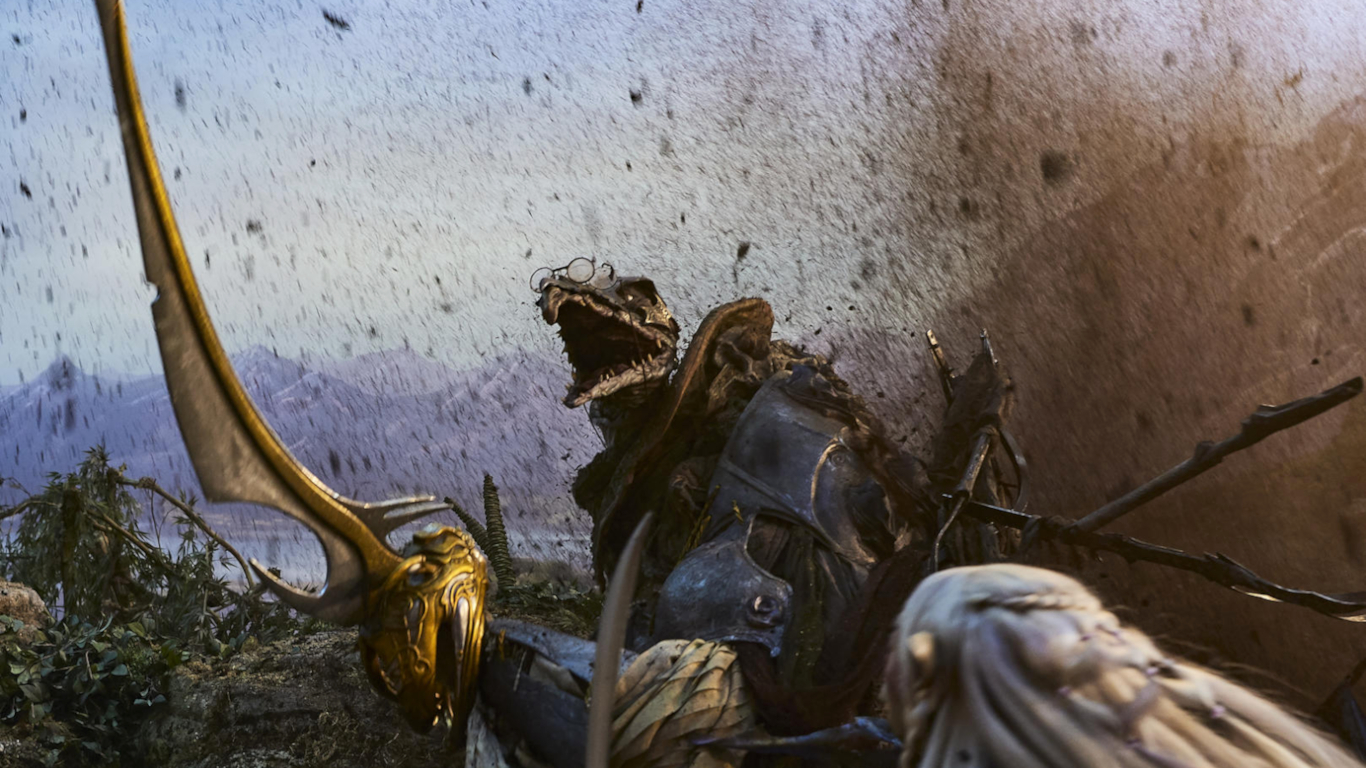
The series owes its success to a deep respect for the source material and the enthusiasm of all involved. Henson is no longer with us and Frank Oz not returning to direct, but the world of Thra began in the imagination of legendary illustrator Brian Froud, who returns as a conceptual consultant. He worked closely with Henson for years making the film a richly filled-out environment. Only when they had built the world and populated it with characters did they begin to grow their stories. Here he’s joined by his son Toby, as design supervisor, and wife Wendy, who is a doll, puppet, and propmaker. They had met whilst working on The Dark Crystal and their son, Toby, appeared as the stolen baby in Labyrinth. I can’t think of a better-qualified triumvirate to get involved if you’re trying to make another story in The Dark Crystal universe.
For long-standing fans of the movie, this series is like a historical epic. In the film, the Gelfling are all but legendary in the mythos of Thra. There are only two left to fulfil an age-old prophecy. For Age of Resistance, we get the stories of the Gelfling and a political world-spanning hierarchy that rivals Game of Thrones, with seven clans and seven matriarchs (known as Maudra) ruling over them.
The title for each episode is taken from a line in the original movie, highlighting the poetic resonances and cyclic nature of the stories. The series is basically a straightforward quest narrative, but with a few different adventures woven together. We most closely follow the stories of the three sisters: Brea (voiced by Anya Taylor-Joy, performed by Alice Dinnean), Tavra (voiced by Caitriona Balfe, performed by Neil Sterenberg), and Seladon (voiced by Gugu Mbatha-Raw, performed by Helena Smee), who are daughters of the Vapran All-Maudra Mayrin (voiced by Helena Bonham Carter, performed by Louise Gold). Then there’s the gentle Deet (voiced by Nathalie Emmanuel, performed by Beccy Henderson and Katherine Smee) of the subterranean Grottan clan, and brave Rian (voiced by Taron Egerton, performed by Neil Sterenberg) of the Stonewood clan. Their individual quests are intrinsically linked and they often come together whilst following their separate stands throughout.
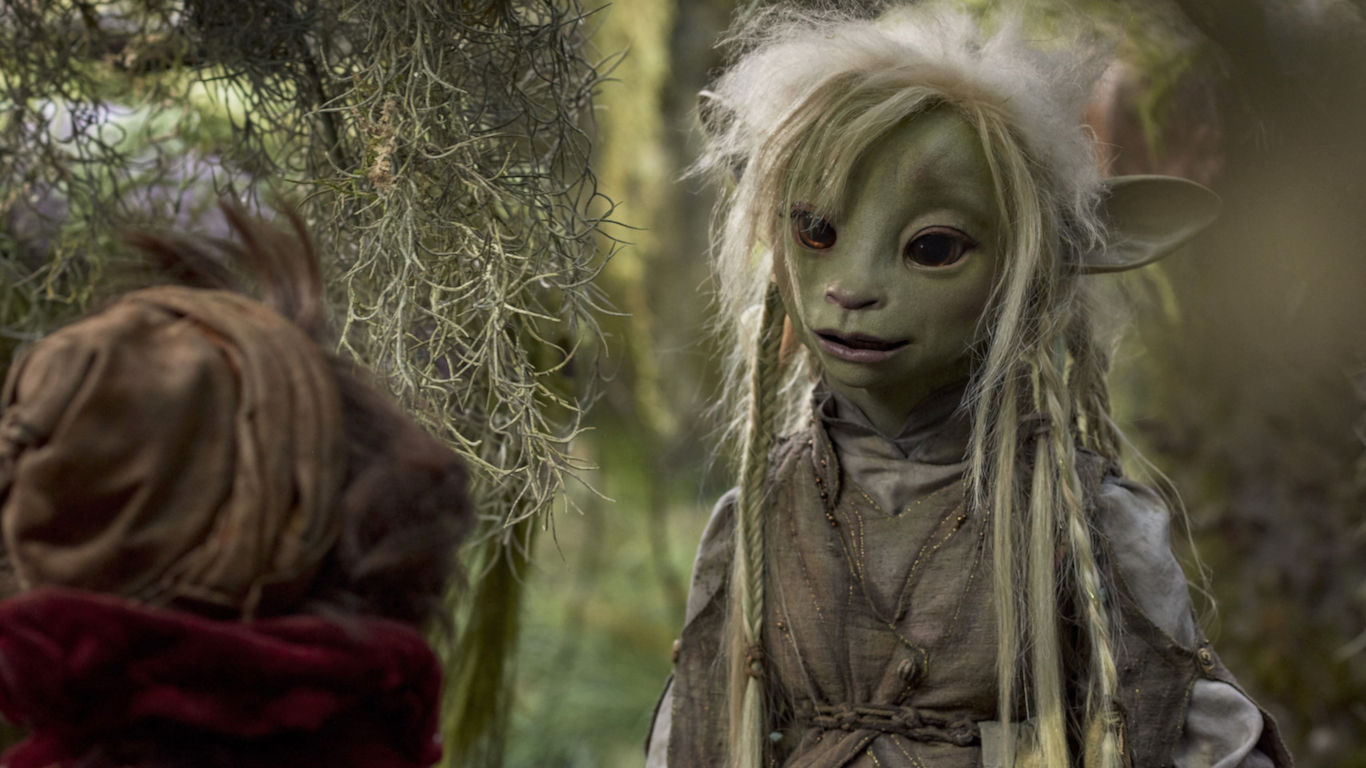
One strength Age of Resistance has over the film is that these Gelfling characters are better defined; growing and changing as events unfold. They all have their own separate and satisfying arcs. Except for one, who survives their climactic heroism but may, or may not, have been taken by the Darkening… their arc is left hanging dramatically in the balance as a teaser for the second season.
It’s very hard to fault this series. Among my minor quibbles would be that I still found the Podlings a little irritating, but I think they’re supposed to be. Though we all grew rather fond of Hup (Victor Yerrid), the little guy who’s brave enough to fight using a wooden spoon, until he earns his sword as a Palladin. There’s also the McGuffin of the magical sword known as the Dual Glaive, with a shard of the Crystal at its hilt. But, really, that’s fine—all good myths must have their Excalibur and Age of Resistance should be commended for keeping the fantasy trudging to a minimum even though the lovely landscapes beg to be showcased.
By the third episode, “What Was Sundered and Undone”, I felt that I wasn’t keeping track of things, so I actually started making notes of who’s who and which quest they were on. But I should’ve trusted the writers because it all fell into place over the next few episodes and became a lot clearer. By the mid-point, the different factions unite to stand against the Skeksis in a kind of ‘fellowship of the crystal’ and the last two parts seemed to rush to the series finale. But why waste time with filler when we can see how it’s all coming together? Having said that, there are a couple of surprises that are admirably hard to predict.
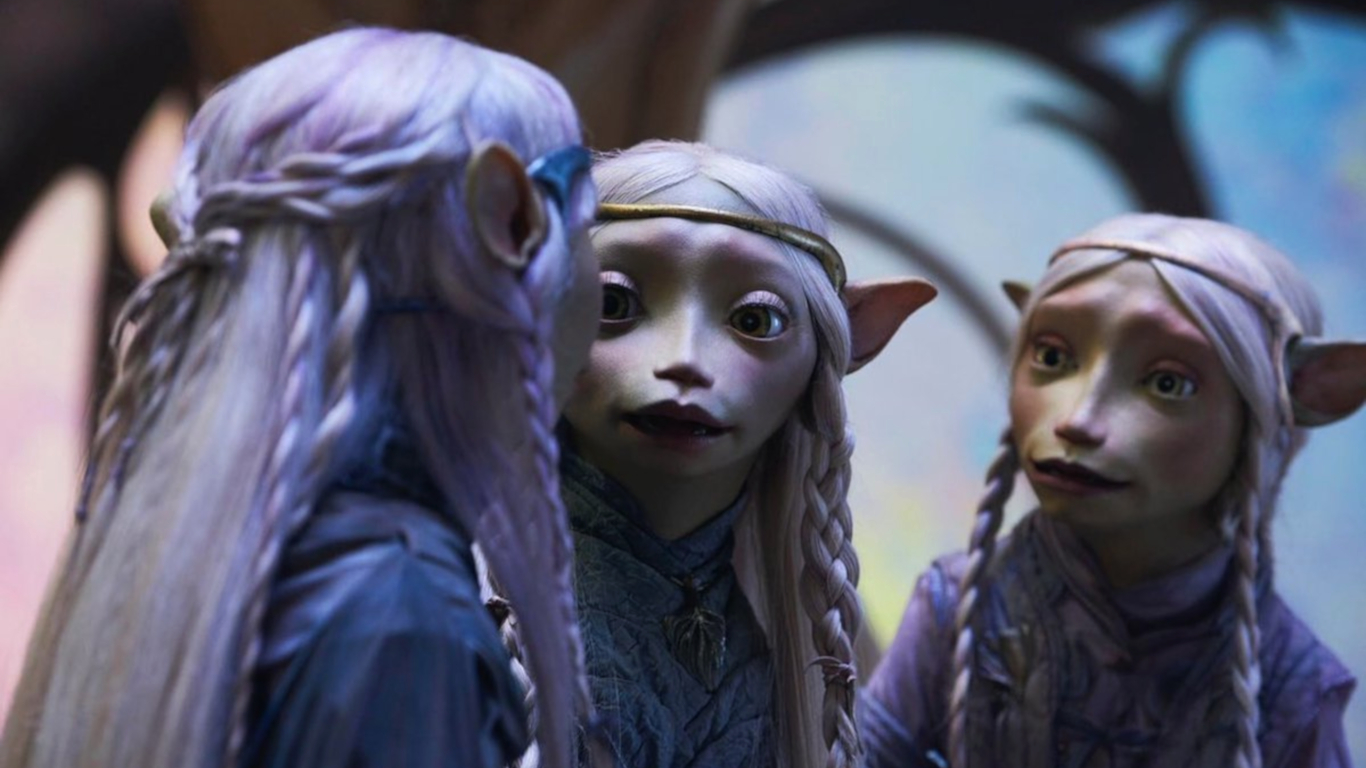
The journey of Seladon was a central strand that didn’t quite bear up to scrutiny for me. She’s one of the three sisters who becomes embittered, supposedly because she’s unable to impress her mother. And, resenting the easier life cut-out for her younger sisters, descends into evil ways and aligns with the Skeksis. But she goes super-bad! Presumably, her judgement’s clouded by rage and grief and other dark emotions she’s unused to feeling. But to me, it seemed a little forced and I felt she was the only character bent out of shape to serve the story rather than to drive it. That stereotypical embittered and deranged villain was a bit too familiar. But, in mythic fantasy, we should expect one or two stock characters, and it didn’t detract from an excellent story in which the characters—yes even Seladon—all developed and grew as we intimately shared their individual journeys.
The introduction of the Dousan Clan must rank as one of my favourite elements, as they appear in the desert skies riding a giant manta-beast that looks like it flew out of a Linkin Park video. The death-cult Gelflings reminded me very much of the Djinn from another of Leterrier’s films, Clash of the Titans (2010), which he completed just before joining The Dark Crystal production.
Another excellent and audacious sequence is the meta-levelled puppet show that skekGra the Heretic (voiced by Andy Samberg, performed by Damian Farrell) and urGoh the Wanderer (voiced by Bill Hader, performed by Olly Taylor) put on to explain the history of Thra to their Gelfling questors. Puppets doing a puppet show! Oh, and not forgetting the return of Aughra (voiced by Donna Kimball, performed by Katherine Smee and Kevin Clash)… well, she’s a force of nature and pivotal to the plot, enough said.
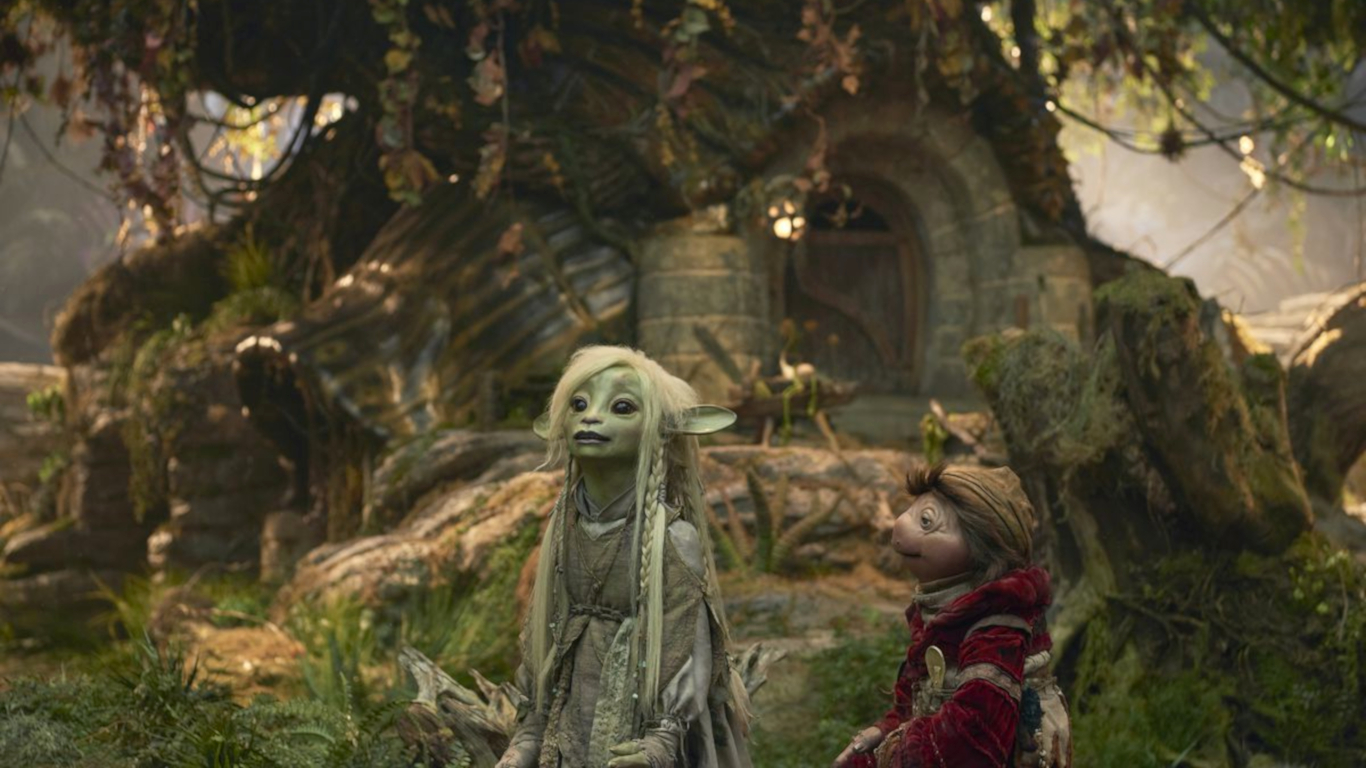
Once more the team pulled off the grand illusion consummately. And sustained it over 10 hours! I kept thinking ‘where have I seen that actor before?’ Not ‘where have I heard that voice?’ I started to think of the puppets as real living people, that’s how good the performance teams behind each character is. And the puppets are never the product of one performance. They became their own entities, a combination of original concept from Froud, developed into maquettes by his son Toby and then mediated by teams of sculptors, model-makers, costume and wigmakers, animatronic designers, 3D-print technicians, puppeteers, voice actors, skilful lighting, and camerawork. The voice cast added their performances after the puppet performances set out their timing and intonation, implied by gestures.
According to Lisa Henson, one of the few aspects that her father hadn’t been entirely happy with was the acting of the Gelfling puppets in close shots, where they had to project emotion. He was worried the illusion would fail and the audience would “see the puppet”. Apparently, that’s one of the reasons why there are so few close-ups during the film’s more touching interactions. Those who have seen the series will agree that this was no longer a problem. That’s due to keeping a subtle element of that “cutting-edge CGI”. The character faces are sensitively enhanced, following the lead of the puppeteer’s performance but adding smoother eye movement, a brow furrow here, a better-timed blink there.
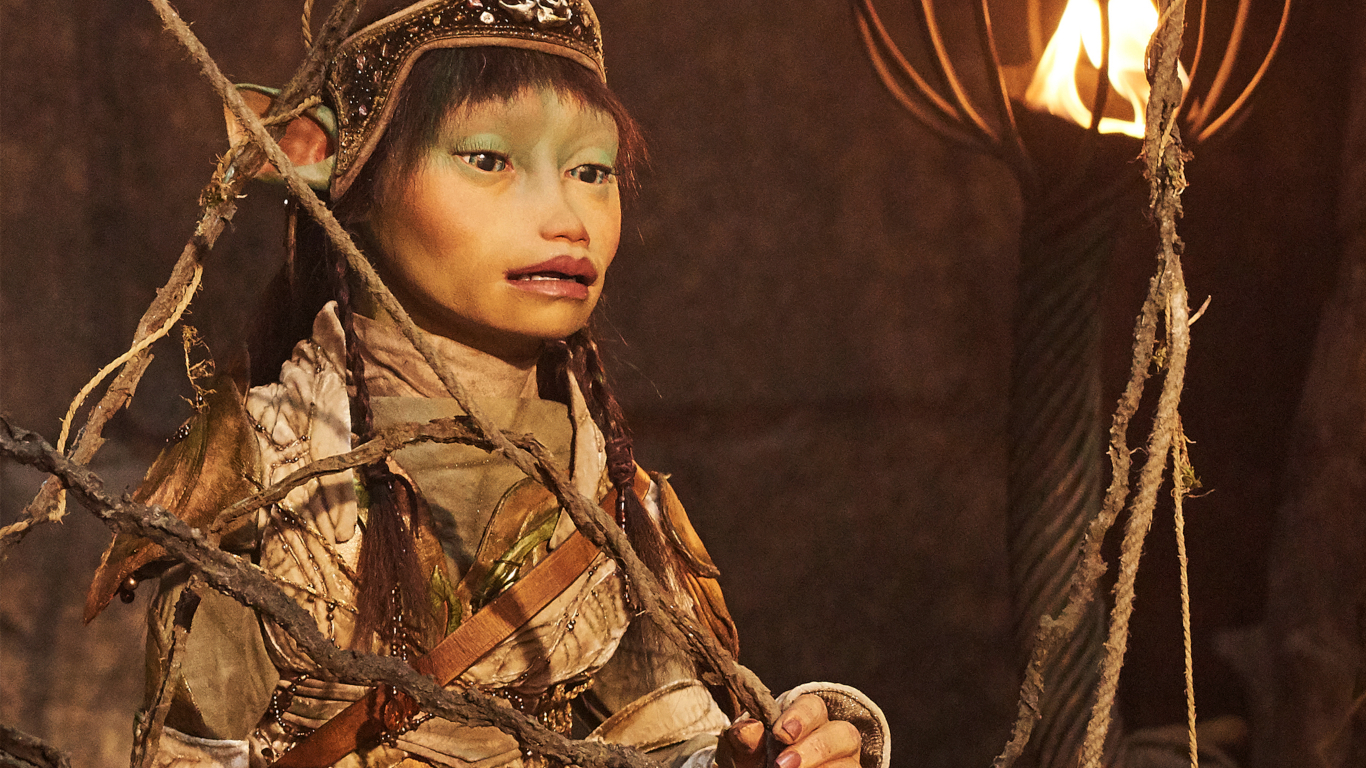
The CGI proved essential elsewhere, too, and was used sparingly to enhance the sets, models, and miniatures. In place of matte paintings, some backdrops were added digitally, and for shots where a whole character had to do something spectacular (such as swim, climb, or fly) then CGI was used to complete the illusion. There’s also extensive use of external puppeteers who were removed digitally in post-production. I was wondering how Lore (a character made from a levitating pile of rocks) was done!
Coming up into our real world, after immersion in the world of Thra needed some decompression time. People looked and moved weird after fully acclimatising to puppets! So, right after the final episode, to help alleviate withdrawal symptoms, we rolled straight on with a re-watch of the 1982 movie, and it looked so much more decadent and desperate. The sets and the Skeksis were decrepit. It felt like they were senile, staring at their inevitable demise. It still feels epic, but after the density of the series, also slighter than I recalled.
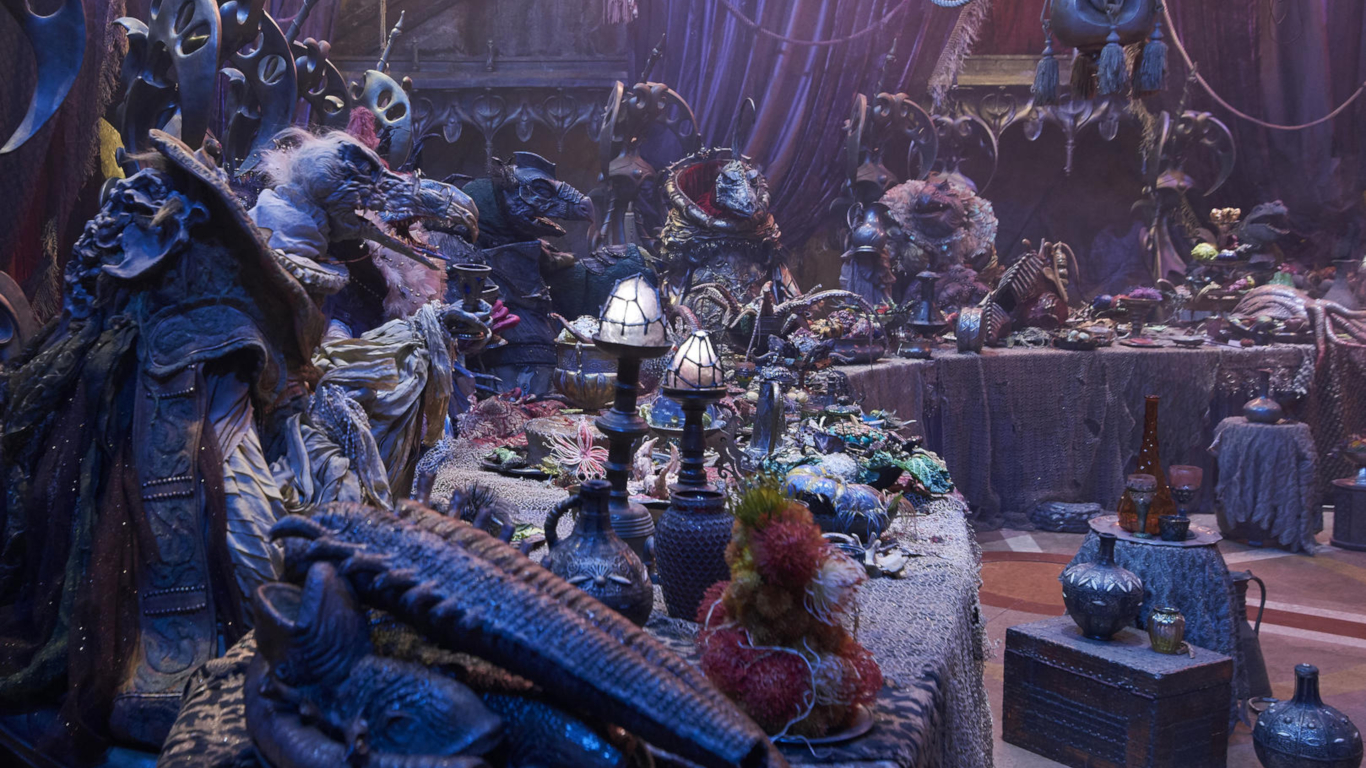
The series tells a much bigger story using a far broader canvas. Watching the original film directly afterwards brings home how faithful the series was to the mythos and world-building set down by Froud and Henson 37 years earlier, but also how much happens between the end of Age of Resistance and the end of the Skeksis. For one thing, all the Gelfling clans get wiped out, which throws a bit of a damper on any planned second season that may attempt to fill the gap between. Surely that would be too dark and despairing unless clever writers can inject a twist we haven’t guessed. Maybe there are forgotten clans of Gelfling that survived in hiding down in the Grottan caverns? Living in harmony with the Arathim, biding their time until the fall of the Skeksis as foretold in the prophecy…
Or perhaps it would be better to move onto a sequel story? There are already some in existence in book and graphic novel form. Perhaps go right back to an origin story, the arrival of the urSkeks, and why the Gelfling separated into their seven separate clans in the first place?
Co-creator Jeffrey Addiss has said “we have a concrete document for season two. We are ready to go.” And, according to Lisa Henson, when Addiss and Will Matthews pitched their version of the series, it continued past where we have left it…
It would be almost negligent for Netflix not to renew The Dark Crystal: Age of Resistance. The world of Thra is like having the Greek myths to play in! It has been well-received by audiences and critics alike and seems built for fandom. I can’t wait for the action figures to come out! Deet, Lore, and the Chamberlain are top of my wishlist. Well, whatever happens in the world of Thra, I’m there, ready and waiting!

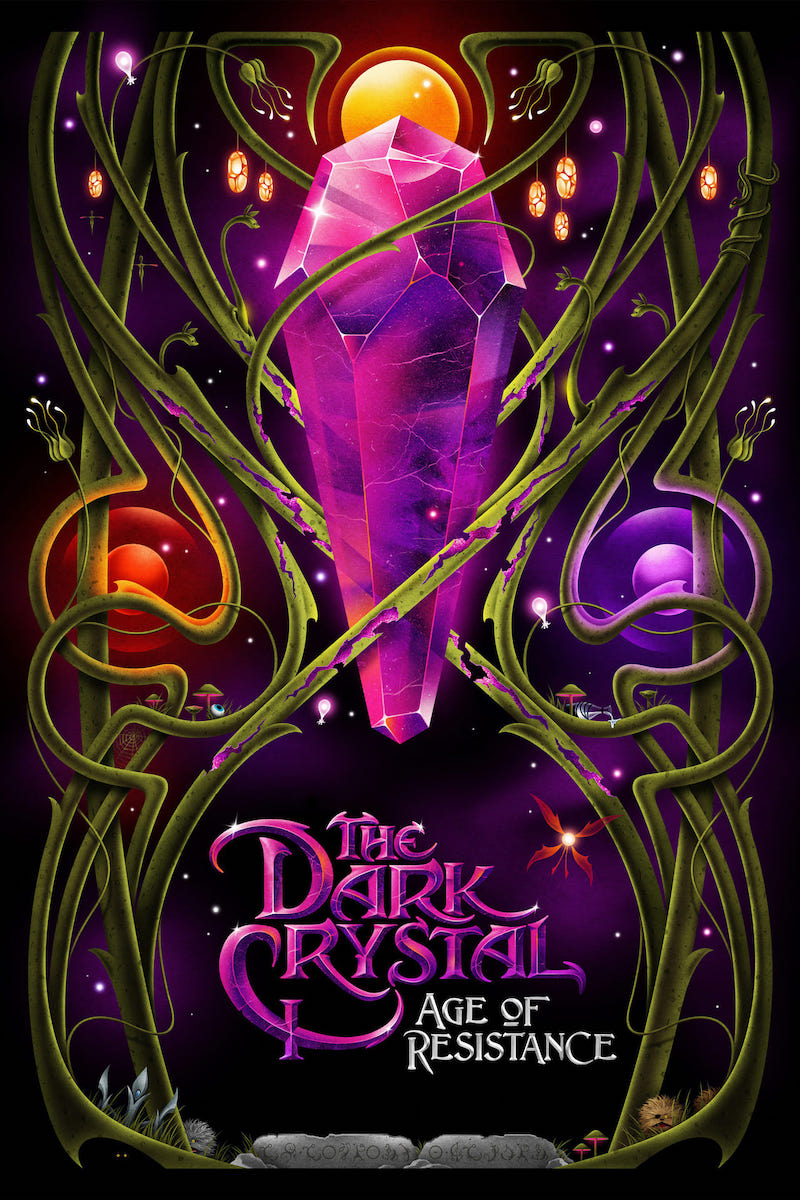
writers: Jeffrey Addis, Will Matthews, J.M Lee, Vivian Lee, Simon Racioppa, Richard Elliott, Kari Drake, Javier Grillo-Marxuach & Margaret Dunlap.
director: Louis Leterrier.
voices: Taron Egerton, Anya Taylor-Joy, Nathalie Emmanuel, Simon Pegg, Mark Hamill, Jason Isaacs, Donna Kimball, Victor Yerrid, Caitriona Balfe, Gugu Mbatha-Raw, Andy Samberg & Helena Bonham Carter.
puppeteers: Warwick Brownlow-Pike, Dave Chapman, Kevin Clash, Daniel Dewhirst, Alice Dinnean, Damian Farrell, Louise Gold, Beccy Henderson, Helena Smee, Katherine Smee, Neil Sterenberg, Olly Taylor & Victor Yerrid.
